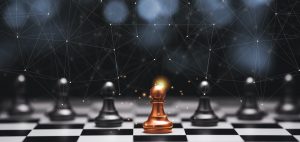Drawing on his experiences as a consultant during China’s period of explosive growth, the University of Bath School of Management’s Stephen Wyatt considers the capabilities required to thrive in the highly dynamic context of the fourth industrial and the value of a saying commonly attributed to Lao Tzu
I worked in China in its period of explosive growth, from the early 1990s to 2008, when the country went from bicycles, Mao-suits and new cities dusted with sand swept in from deserts, to being the biggest market globally for luxury goods, having the biggest television audience globally for an international polo match (the so-called ‘sport of kings’) and a place where 21 is the average age of a Maserati driver.
Growth of economies in China and Southeast Asia
As a strategy and business consultant, I sought to bridge the gaps between the expectations and operating practices of many major western corporations and also help navigate the opportunities, risks and dynamics of business in China. As China’s economy surged ahead, data was always lacking, there were continual shortages in skills and experience, and regulation lagged far behind, resulting in occasional episodic ‘course-corrections’ that incumbents usually lamented. In the excitement of this bubbling cauldron, huge fortunes were made by those with an impressive ability to make sense of the unfolding changes, who had the decisiveness needed to seize initiatives, and who were able to fluidly reconfigure operations and reposition offerings.
Capabilities were hard to replicate for many western corporations, whose decision makers were far from China and who first needed to first analyse reliable data before deciding. I had been schooled in western business practices so, to help me understand how Chinese business leaders might be thinking, a colleague introduced me to an extract of Chinese philosophy, reputedly from the sixth century BCE and attributed to Lao Tzu (although others have said it was from either Confucius or Xunzi): ‘Those who have knowledge don’t predict. Those who predict don’t have knowledge’. [Lao Tzu is the reputed author of the Tao Te Ching and the founder of philosophical Taoism.]
Executives in China and the ‘tiger’ economies of Southeast Asia were immersed in and focused on highly dynamic volatile, uncertain, complex and ambiguous (VUCA) contexts of business. They knew the weakness of forecasts (predictions). Yet many a corporate system, optimised for more stable market conditions elsewhere, depended on periodic formalised forecasting, budget allocation and decision-making processes. In my work with clients, I started to focus more and more on developing the management and leadership capabilities to thrive in highly dynamic marketspaces, rather than seeking only to resolve tensions and complications due to the different paradigms between headquarters and local operations or joint-venture partners. An executive at the agrichemicals company, Syngenta, once told me: ‘Here we are [in the tiger economies], but Harvard didn’t teach us how to ride tigers!’
The new context of business
Over the past 20 years, the fourth industrial revolution has gathered pace globally. The development and application of new technologies (for example, the Internet of Things, AI, robotics, biotech, nanotech, blockchain, and machine learning) is facilitating significant acceleration of business, making disruptions and highly dynamic VUCA contexts increasingly accepted as the norm. Leading firms are shaping the future as it unfolds, new business models are emerging, sector boundaries are being breached, incumbents are collapsing while unprofitable startups, known as ‘unicorns’, are being valued at more than $1 billion USD.
Strategic decisions have to be made relying on data of the past and present, even though it is recognised as decreasingly representative of the future. Regulators struggle to keep up with new norms of corporate behaviour, leading to inquests (for example, the repeated appearances of Facebook before US Senate Committees), remedial actions (for example, China’s 2021 ruling against ride-share company, DiDi Chuxing) and substantial fines (for example, EU fining Google $5 billion USD for abuse of power with its search engine). The dynamics (pace of evolution, disruption, rate of wealth creation and destruction, scarcity of data for strategic decision making, lagging regulation) that face business leaders in the fourth industrial revolution are reminiscent of the dynamics some faced when China and Southeast Asia were the booming frontiers. So what are the capabilities required to thrive in these contexts?
Possiblity not probability
The first and perhaps most important difference between traditional approaches to strategic decision making and those required in the accelerated VUCA context of the fourth industrial revolution is to embrace ‘possibility not probability’. We can’t gather and analyse data on the future. However, as Canadian scholar Henry Mintzberg pointed out, it is equally wrong to depend on the precision of a forecast for decision making as it is to not predict a possible future.
My research with executives at corporations that do thrive in the dynamic fourth industrial revolution shows the importance of adopting a compelling vision of the future; the possibility, to set often audacious growth objectives in the pursuit of a societal purpose. This forward-leaning strategic posture establishes the orientation to shape the future. It provides directional guidance for where the organisation is heading, course correcting as the future unfolds, encountering both the expected and unexpected challenges. ‘Possibility not probability’ requires executives to think more broadly than unifying on a singular view of the future – what could the opportunities and threats be? The next step is to then decide on which of these to act and on which to keep a watchful eye, ready to act if they actually manifest. A most useful strategic planning technique in these dynamic marketspaces is ‘scenario planning’, through which ideas for action are both identified and placed into one of four categories: ‘Do it’; ‘Be ready to fast-respond’ (if it unfolds); ‘Create an option’ (i.e. lay the foundations for an alternative initiative, but don’t commit just yet); ‘Have an alternative back-up plan’ (what would we do if our main beliefs about the future are proved wrong).
Adaptation
The second set of capabilities are those required for the corporation to adapt in a timely manner – the ‘what it does’ and ‘how it does it’. This requires: developing a heightened ability to sense the future, and make sense of it, as it unfolds; being attentive to weak (and stronger) signals and early indicators; and being able to determine the ‘so, what could this mean for us?’ In this sense, the ability to quickly formulate and implement new initiatives and responses to unfolding opportunities and threats, combined with the ability to replicate them and scale rapidly, is important.
The third complementary capability in this group is the ability to fluidly reconfigure the resources of the corporation to enhance flexibility and efficiency in support of the adjusting array of initiatives; for example, outsourcing or in-sourcing, changing organisation structure, adjusting or duplicating supply chains, and so on.
Winning the race for talent
The third set of capabilities addresses the constant shortage of skilled and experienced talent. In fast-evolving marketspaces, the talent and skills required for a corporation to thrive tomorrow are constantly evolving, i.e. the idea that ‘what got us here is insufficient to take us there’. Over the five years from 2020 to 2025, the World Economic Forum estimates that more than 97 million people will need to upskill or reskill due to the new technologies and working practices of the fourth industrial revolution.
‘Winning the race for talent’ is more important than ‘winning the war for talent’, as an external pool of talent with relevant skills and experiences simply does not exist. To win the race for talent requires constant investment in training and development, fluidly deploying and redeploying talent to the roles requiring those skills as the roles change, and retaining the wellbeing of that valuable talent within the corporation, through human-centred policies and practices.
For some executives, the skills that are required to thrive in the highly dynamic context of the fourth industrial revolution may echo skills they first explored in the once-tiger economies of Asia. Others will need to free themselves from the false precision of forecasts, or the comforting – yet constraining – periodic strategic planning processes. They might also do well to reflect that: ‘Those who have knowledge don’t predict. Those who predict don’t have knowledge’ and to instead think about possibility not probability.
Stephen Wyatt is Professor of Strategy and Leadership at University of Bath School of Management, Industrial Associate at the University of Cambridge and author of Management & Leadership in the 4th Industrial Revolution (Kogan Page, 2020).




























